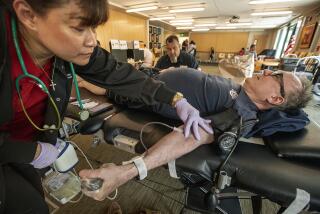The Bone Marrow Donation Process
- Share via
The National Marrow Donor Program helps patients with leukemia or other blood diseases find matching, unrelated bone marrow donors for transplants. Information: (800) MARROW2.
The City of Hope has the country’s second-largest bone marrow transplant center. It is affiliated with the national registry, so people who donate blood at the City of Hope are screened for potential matches with bone marrow transplant candidates nationwide. Information: (818) 301-8386.
Donors must be 18 to 56 years old and in good health. The process:
* A small amount of blood is taken from the donor at an approved site.
* The sample is analyzed for markers on the surface of white blood cells called “antigens.” The results are entered in the national registry.
* If two of the donor’s key antigens match those of a patient in the registry, the donor is asked to give another small sample of blood. Four more of the donor’s antigens are typed and compared to the patient’s.
* If all six antigens match, the donor is counseled about the donation process and given a physical examination. Donors who wish to proceed sign an “intent to donate” form. All expenses are paid by the recipient’s insurance.
* Donated marrow is extracted in a simple surgical procedure under general anesthesia at an approved hospital. Doctors extract 2% to 5% of the donor’s liquid marrow from the back of the pelvis with a special needle and syringe.
* The donor is kept in the hospital overnight for observation.
* After the procedure, the donor’s lower back area is sore for about a week. The donor’s marrow replenishes itself within a few weeks.
* After a year, the registry sends consent forms to both the donor and recipient, asking whether or not they want contact with the other.






